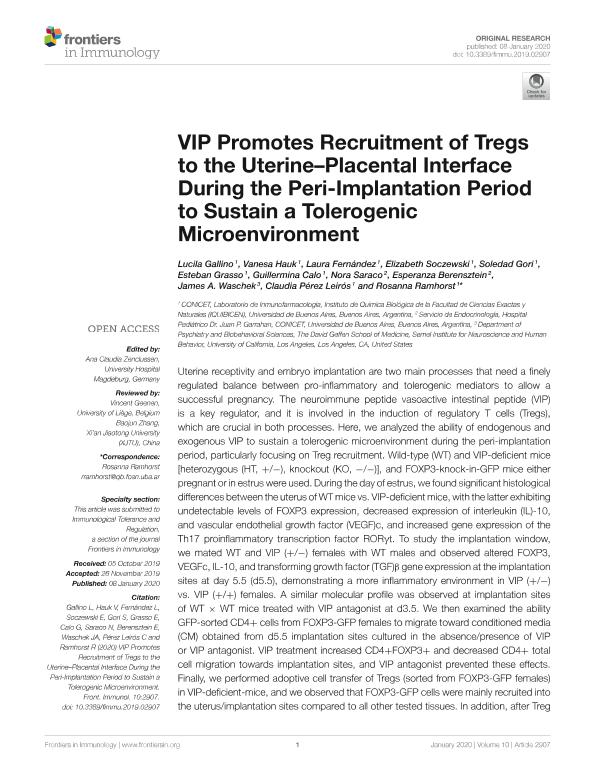Artículo
VIP Promotes Recruitment of Tregs to the Uterine–Placental Interface During the Peri-Implantation Period to Sustain a Tolerogenic Microenvironment
Gallino, Lucila ; Hauk, Vanesa Cintia
; Hauk, Vanesa Cintia ; Fernández, Laura; Soczewski, Elizabeth Victoria
; Fernández, Laura; Soczewski, Elizabeth Victoria ; Gori, María Soledad
; Gori, María Soledad ; Grasso, Esteban Nicolas
; Grasso, Esteban Nicolas ; Calo, Guillermina
; Calo, Guillermina ; Saraco, Nora Isabel
; Saraco, Nora Isabel ; Berensztein, Esperanza Beatriz; Waschek, James A.; Perez Leiros, Claudia
; Berensztein, Esperanza Beatriz; Waschek, James A.; Perez Leiros, Claudia ; Ramhorst, Rosanna Elizabeth
; Ramhorst, Rosanna Elizabeth
 ; Hauk, Vanesa Cintia
; Hauk, Vanesa Cintia ; Fernández, Laura; Soczewski, Elizabeth Victoria
; Fernández, Laura; Soczewski, Elizabeth Victoria ; Gori, María Soledad
; Gori, María Soledad ; Grasso, Esteban Nicolas
; Grasso, Esteban Nicolas ; Calo, Guillermina
; Calo, Guillermina ; Saraco, Nora Isabel
; Saraco, Nora Isabel ; Berensztein, Esperanza Beatriz; Waschek, James A.; Perez Leiros, Claudia
; Berensztein, Esperanza Beatriz; Waschek, James A.; Perez Leiros, Claudia ; Ramhorst, Rosanna Elizabeth
; Ramhorst, Rosanna Elizabeth
Fecha de publicación:
01/2020
Editorial:
Frontiers Media S.A.
Revista:
Frontiers in Immunology
ISSN:
1664-3224
Idioma:
Inglés
Tipo de recurso:
Artículo publicado
Clasificación temática:
Resumen
Uterine receptivity and embryo implantation are two main processes that need a finely regulated balance between pro-inflammatory and tolerogenic mediators to allow a successful pregnancy. The neuroimmune peptide vasoactive intestinal peptide (VIP) is a key regulator, and it is involved in the induction of regulatory T cells (Tregs), which are crucial in both processes. Here, we analyzed the ability of endogenous and exogenous VIP to sustain a tolerogenic microenvironment during the peri-implantation period, particularly focusing on Treg recruitment. Wild-type (WT) and VIP-deficient mice [heterozygous (HT, +/−), knockout (KO, −/−)], and FOXP3-knock-in-GFP mice either pregnant or in estrus were used. During the day of estrus, we found significant histological differences between the uterus of WT mice vs. VIP-deficient mice, with the latter exhibiting undetectable levels of FOXP3 expression, decreased expression of interleukin (IL)-10, and vascular endothelial growth factor (VEGF)c, and increased gene expression of the Th17 proinflammatory transcription factor RORγt. To study the implantation window, we mated WT and VIP (+/−) females with WT males and observed altered FOXP3, VEGFc, IL-10, and transforming growth factor (TGF)β gene expression at the implantation sites at day 5.5 (d5.5), demonstrating a more inflammatory environment in VIP (+/−) vs. VIP (+/+) females. A similar molecular profile was observed at implantation sites of WT × WT mice treated with VIP antagonist at d3.5. We then examined the ability GFP-sorted CD4+ cells from FOXP3-GFP females to migrate toward conditioned media (CM) obtained from d5.5 implantation sites cultured in the absence/presence of VIP or VIP antagonist. VIP treatment increased CD4+FOXP3+ and decreased CD4+ total cell migration towards implantation sites, and VIP antagonist prevented these effects. Finally, we performed adoptive cell transfer of Tregs (sorted from FOXP3-GFP females) in VIP-deficient-mice, and we observed that FOXP3-GFP cells were mainly recruited into the uterus/implantation sites compared to all other tested tissues. In addition, after Treg transfer, we found an increase in IL-10 expression and VEGFc in HT females and allowed embryo implantation in KO females. In conclusion, VIP contributes to a local tolerogenic response necessary for successful pregnancy, preventing the development of a hostile uterine microenvironment for implantation by the selective recruitment of Tregs during the peri-implantation period.
Palabras clave:
EARLY PREGNANCY
,
IMPLANTATION
,
TOLERANCE
,
TREGS
,
VIP
Archivos asociados
Licencia
Identificadores
Colecciones
Articulos(IQUIBICEN)
Articulos de INSTITUTO DE QUIMICA BIOLOGICA DE LA FACULTAD DE CS. EXACTAS Y NATURALES
Articulos de INSTITUTO DE QUIMICA BIOLOGICA DE LA FACULTAD DE CS. EXACTAS Y NATURALES
Citación
Gallino, Lucila; Hauk, Vanesa Cintia; Fernández, Laura; Soczewski, Elizabeth Victoria; Gori, María Soledad; et al.; VIP Promotes Recruitment of Tregs to the Uterine–Placental Interface During the Peri-Implantation Period to Sustain a Tolerogenic Microenvironment; Frontiers Media S.A.; Frontiers in Immunology; 10; 1-2020; 1-14
Compartir
Altmétricas



